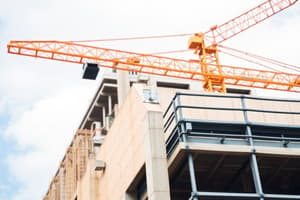Podcast
Questions and Answers
What is the purpose of selecting a country in the project?
What is the purpose of selecting a country in the project?
- To calculate wind velocity and pressure
- To determine the altitude above sea level
- To classify structures based on consequence classes
- To access predefined data for wind/snow zones and terrain categories (correct)
Orography refers to the study of atmospheric pressure.
Orography refers to the study of atmospheric pressure.
False (B)
What is the primary factor that affects wind loads?
What is the primary factor that affects wind loads?
Forces from wind
The shape and features of the land are referred to as _______________________.
The shape and features of the land are referred to as _______________________.
What is the classification of structures based on the impact of their failure?
What is the classification of structures based on the impact of their failure?
Eurocode is used for countries that are not listed in the dropdown menu.
Eurocode is used for countries that are not listed in the dropdown menu.
Match the following consequence classes with their descriptions:
Match the following consequence classes with their descriptions:
Flashcards are hidden until you start studying
Study Notes
Project Initiation
- The project begins by entering the address, which can be facilitated by using the autofill function to utilize predefined data for calculations.
- Country selection is essential, as each country has specific parameters for wind/snow zones, terrain categories, etc.
Wind and Snow Loads
- Altitude above sea level affects atmospheric pressure, which in turn impacts wind loads.
- Wind loads pose a risk of damaging solar panels, requiring secure mounting and proper orientation.
- Snow loads add weight to structures, necessitating strong support structures and designs that allow snow to slide off.
Terrain and Environment
- Factors like open fields, urban areas, and hills affect wind speeds and snow accumulation.
- Orography refers to the shape and features of the land, which influences wind velocity and pressure.
- Wind speed and pressure are affected by geographic location, terrain, and building height.
Structural Response and Design
- Structural response describes how structures react to wind, including dynamic effects.
- Design procedures outline the necessary steps for applying wind loads in the design process, ensuring structures are safe and serviceable.
Consequence Classes
- Consequence classes (CC) categorize structures based on the potential impact of their failure.
- CC1: Low risk to life, minor impact (e.g., small storage buildings).
- CC2: Moderate risk to life, significant impact (e.g., residential buildings).
- CC3: High risk to life, severe impact (e.g., large public buildings).
- Consequence classes determine the necessary safety and design robustness.
Studying That Suits You
Use AI to generate personalized quizzes and flashcards to suit your learning preferences.




